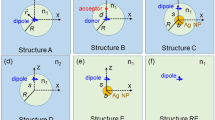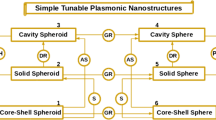Abstract
Light-matter interaction can be strongly enhanced by the confinement of the electric field due to the excitation of plasmonic modes at metal-dielectric interfaces (Gaponenko, Introduction to nanophotonics. Cambridge University Press, Cambridge/New York). In this work we give a theoretical formulation of the interaction between a dipole emitter and the localized surface plasmons of spherical metallic nanoparticles, particularly suitable for studying strong-coupling effects beyond perturbation theory, such as the appearance of vacuum Rabi splitting in the emission spectrum of the dipole (Savasta et al., ACS Nano 4:6369–6376, 2010; Van Vlack et al., Phys Rev B 85:075303, 2012). The threshold for entering the strong-coupling regime can be expressed with a formalism analogous to that of cavity-quantum-electrodynamics, based on a proper definition of the modal effective volume (Maier, Opt Express 14(5):1957, 2006; Agio, Nanoscale 4:692–706, 2012). In particular, we apply the results to the case of a spherical metallic nanoshell in the quasistatic approximation, deriving a spectrum of sphere-like and cavity-like surface plasmon excitations (Prodan and Nordlander, Chem Phys Lett 352:140–146, 2002) whose frequencies and effective volumes are calculated as a function of various geometrical parameters. We show that a vacuum Rabi splitting can occur in emission spectra for dipole oscillator strengths as small as a few units (Alpeggiani et al., Phys Rev B 86:035421, 2012), which can be easily achieved with organic molecules or quantum dots. The most favorable situation for strong coupling is when the dipole is located inside the nanoshell. Surprisingly, this dipole couples with sphere-like modes more strongly than with cavity-like ones, if the shell is thin enough. Our framework can be extended to a fully computational approach in order to investigate the strong-coupling regime of light-matter interaction in more complex geometries.
You have full access to this open access chapter, Download conference paper PDF
Similar content being viewed by others
Keywords
FormalPara AbstractLight-matter interaction can be strongly enhanced by the confinement of the electric field due to the excitation of plasmonic modes at metal-dielectric interfaces (Gaponenko, Introduction to nanophotonics. Cambridge University Press, Cambridge/New York). In this work we give a theoretical formulation of the interaction between a dipole emitter and the localized surface plasmons of spherical metallic nanoparticles, particularly suitable for studying strong-coupling effects beyond perturbation theory, such as the appearance of vacuum Rabi splitting in the emission spectrum of the dipole (Savasta et al., ACS Nano 4:6369–6376, 2010; Van Vlack et al., Phys Rev B 85:075303, 2012). The threshold for entering the strong-coupling regime can be expressed with a formalism analogous to that of cavity-quantum-electrodynamics, based on a proper definition of the modal effective volume (Maier, Opt Express 14(5):1957, 2006; Agio, Nanoscale 4:692–706, 2012). In particular, we apply the results to the case of a spherical metallic nanoshell in the quasistatic approximation, deriving a spectrum of sphere-like and cavity-like surface plasmon excitations (Prodan and Nordlander, Chem Phys Lett 352:140–146, 2002) whose frequencies and effective volumes are calculated as a function of various geometrical parameters. We show that a vacuum Rabi splitting can occur in emission spectra for dipole oscillator strengths as small as a few units (Alpeggiani et al., Phys Rev B 86:035421, 2012), which can be easily achieved with organic molecules or quantum dots. The most favorable situation for strong coupling is when the dipole is located inside the nanoshell. Surprisingly, this dipole couples with sphere-like modes more strongly than with cavity-like ones, if the shell is thin enough. Our framework can be extended to a fully computational approach in order to investigate the strong-coupling regime of light-matter interaction in more complex geometries.
Author information
Authors and Affiliations
Corresponding author
Editor information
Editors and Affiliations
Rights and permissions
Copyright information
© 2015 Springer Science+Business Media Dordrecht
About this paper
Cite this paper
Alpeggiani, F., D’Agostino, S., Andreani, L.C. (2015). Surface Plasmons and Strong Light-Matter Coupling in Metallic Nanoshells. In: Di Bartolo, B., Collins, J., Silvestri, L. (eds) Nano-Structures for Optics and Photonics. NATO Science for Peace and Security Series B: Physics and Biophysics. Springer, Dordrecht. https://doi.org/10.1007/978-94-017-9133-5_35
Download citation
DOI: https://doi.org/10.1007/978-94-017-9133-5_35
Published:
Publisher Name: Springer, Dordrecht
Print ISBN: 978-94-017-9132-8
Online ISBN: 978-94-017-9133-5
eBook Packages: Physics and AstronomyPhysics and Astronomy (R0)




